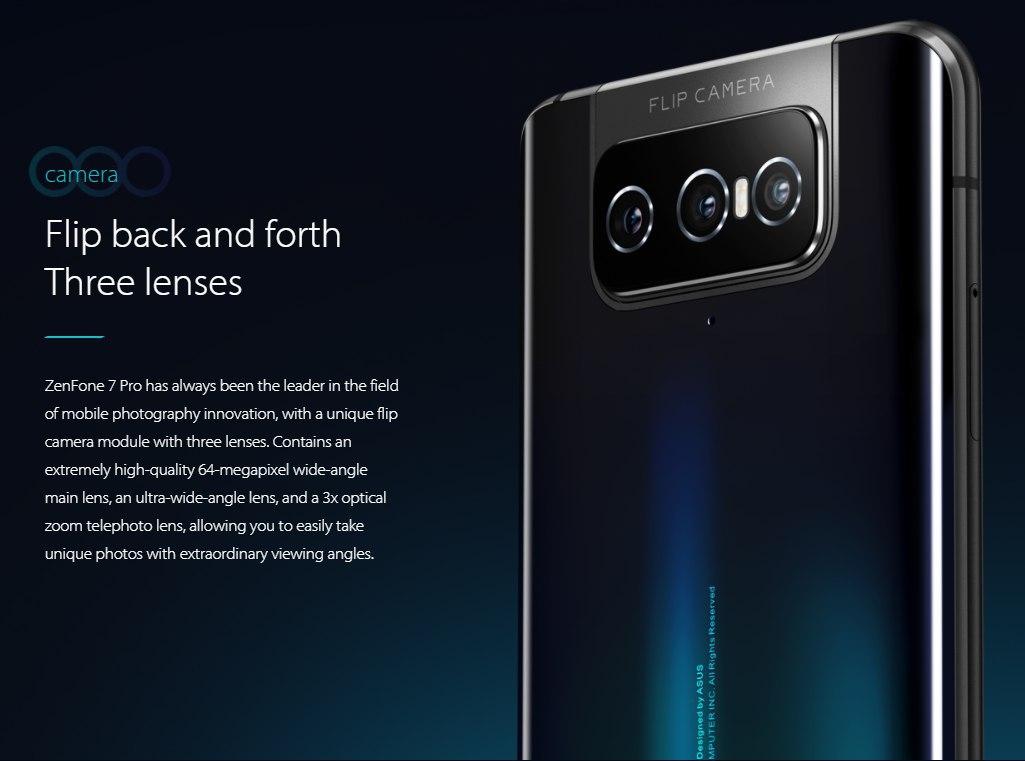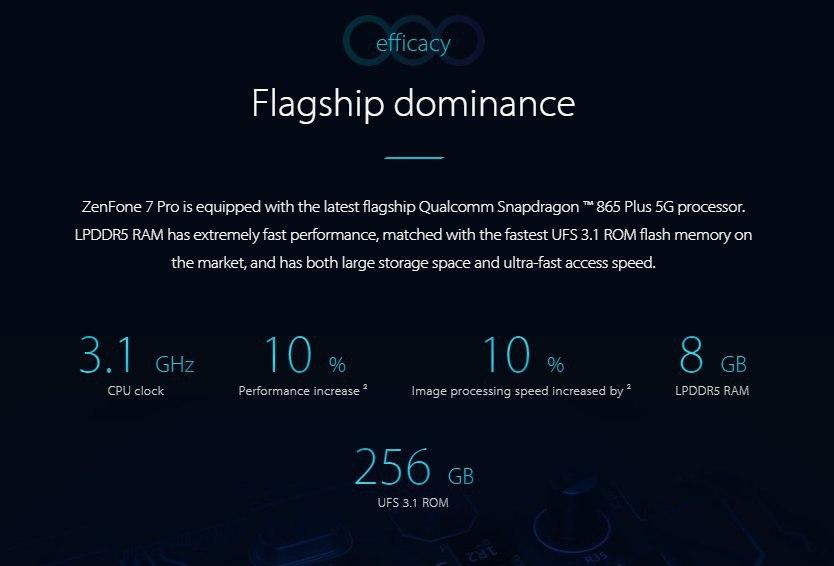
The flip camera on the Zenfone 6 was what made it stand out of the crowd. Now, it’s even revamped with better, more powerful cameras, and an even stronger flip motor. The Zenfone 6 was the most underrated phone of 2019, and now all eyes are on the Zenfone 7 series. So without further ado, lets dig into the specs of the Zenfone 7 series…

Zenfone 7
Cameras:
As stated earlier, the main selling point of the Zenfone series are it’s cameras. The flip camera mechanism makes the phone even more thrilling as this camera mechanism is great for bloggers. The main camera is Sony’s latest 64MP IMX 686 camera found on most flagship phones, coupled again with Sony’s IMX 363 12MP wide angled camera which also doubles as a macro camera. The last but not the least, there’s a telephoto lens with 3x optical zoom, and with that, you could get 12x digital zoom!

CPU and GPU:
As usual, the Zenfone 7 packs Qualcomm’s latest chip, the Snapdragon 865. The Snapdragon 865 is not a slouch at all, with the main A77 core clocked at 2.84GHz, keeping the other 3 A77 cores clocked at a slower, 2.42GHz, while 4 efficiency cores are clocked at a really low 1.8GHz. The A77 cores are speedily fast, and work really well in games and heavy tasks, whereas the A55 cores will suffice for apps like Whatsapp, Facebook, Instagram, Telegram and other apps that require little to no processing power. The Adreno 650 too is a speedy graphics processing unit, and it’s capable of 8k 30fps recording!

Display:
The Display is an AMOLED display, comes with 90Hz refresh rate, has HDR10+, has a size of 6.67 inches using an aspect ratio of 20:9. That makes the phone taller. The display area is 107.4 sq cm, and the entire phone has an 84.2% screen to body ratio. The previous Zenfone had an IPS LCD display, while this one gets the latest AMOLED display that we normally see on most flagships.

Storage and RAM:
The Zenfone 7 comes in 2 variants… 128GB ROM with 6GB ram, and 128GB ROM with 8GB ram. The base variant starts at 128GB. there’s no option of a 64GB ROM variant. That is a great thing as we are slowly moving to higher storage variants. Another better thing about this is the presence of a dedicated card slot! Even the Zenfone 6 had a dedicated card slot. Asus knows their customers love the phone for the card slot, and hence decided to keep it this time too. I fear it may not be available in the Zenfone 8 series, and above… The 128GB storage uses a speedy fast UFS 3.1 with read speeds of over 1.7GB/s and write speeds of up to 1GB/s. The RAM is the latest LPDDR5 ram. We are unsure about the speeds, but it’s gonna pretty fast compared to previous flagships.
Battery & Charging:
The battery is a juicy 5000mAh and can easily last a day or more than a day on heavy usage. A 30 watt charging solution is coupled with this behemoth battery which charges the phone in about an hour and say 5 to 10 minutes. Most flagships have 4500mAh batteries with faster charging, but in the end, battery capacity trumps charging speed. But the charging speed isn’t bad at all. The Zenfone 6 charges in 2 and a half hours while the Zenfone 7 charges in an hour and half. Cutting the charging time by an hour is quite an impressive feat.
Wifi, Bluetooth, GPS, etc:
Asus added the latest Wifi standard, Wifi 6 or ax which uses a combination of both 2.4 and 5GHz. Wifi 6 also has more benefits such as 1024 QAM, OFDMA (Orthogonal Frequency Davison Multiple Access) and a larger 160MHz channel along with 8×8 MIMO, allowing you to quadruple the bandwidth, giving you a faster, speedier lag free internet experience. The Bluetooth on the other hand is 5.0 and has features like A2DP, LE, and aptX Adaptive. The GPS used is A-GPS, GLONASS, GALLIEO, BDS, QZSS and NavIC.
Fingerprint reader:
The best part about this is the fingerprint reader. It acts as a power button, as well as an all in one button/key. You can customize it to bring down the notification bar, including starting a few apps with various clicks.
Zenfone 7 Pro
While the Zenfone 7 pro is the better version, there are very few differences between them both. Let’s go through the main specs…
Camera:
The Camera housing consist of the same triple camera setup as it’s younger sibling, the Zenfone 7 but with an added benefit of OIS or Optical Image Stabilization for the main camera(64MP) and telephoto camera(8MP). OIS helps stabilize the video recording, and makes it crystal clear, and smooth.
Processor:
One of the main differences between the Zenfone 7 and the Zenfone 7 pro is the processor. Zenfone 7 houses the Snapdragon 865 whereas the Zenfone 7 pro uses the latest Snapdragon 865+. The 865+ has around 10% more performance than it’s 865 counterpart.

Storage:
The Zenfone 7 has 2 variants, 6GB ram along with128GB storage, as well as 8GB ram and the same 128GB storage. But the 7 pro has an upgraded storage of 256GB, along with the same 8GB ram. The major difference between the Zenfone 7 series and it’s lower counterpart, the Zenfone 6 is that the storage has an upgrade from UFS 2.1 to UFS 3.1. It’s a major upgrade to be honest. The RAM too has an upgrade with LPDDR5 from LPDDR4 on the previous Zenfone.
As usual, most of the remaining specs are similar to that of the Zenfone 7.
So, are the Zenfone series going to be in your hands any time soon? If so, do let us know in the comments below.
